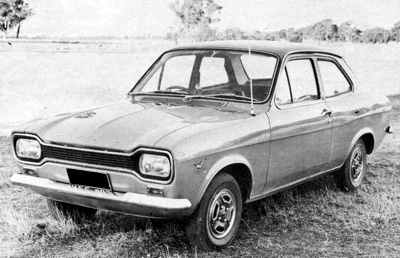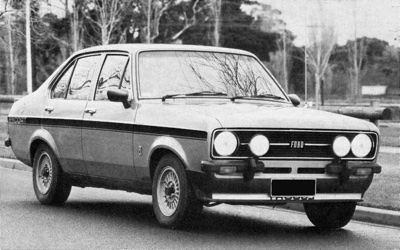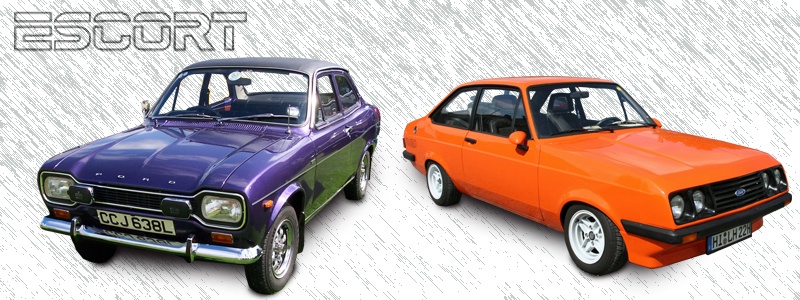Ford Escort, from Suburban Runabout to Rally Champion
At the time, Ford's Escort was one of the best small cars available; it was reasonably priced, its interior space was better than average and it had taut, precise handling which made it a pleasure to drive but. On paper at least, everything was looking good. But Ford's quality control was very much hit-and-miss back then, and many Escorts left the factory in a condition which went on to cause heartbreak to the then proud new-car owner. Ask your mm or dad if they owned an Escort. Then ask if they would have bought another. Out money is on them replying "loved it, but never again".
The below-average standard of finish was often aggravated by indifferent dealer service and small problems which should have been fixed up in a few minutes early in the car's life, but these little niggles often snowballed into a long list of customer complaints that some owners will have forgotten today - but the truth sometimes hurts. The one test of the reliability of a car is in the resale value, and owners of the Escort were hit hard, particularly when compared to those that had chosen, some would argue wisely, a Japanese competitor: back then you had the choice of buying a well-built but boring Nipponese machine which would hold its value, or of buying an Escort which would be a delight to drive but would probably have reliability problems and cost a fair bit in depreciation. But Enough of the bad bits.
What the Escort offered was a small five-seater sedan with comfortable seating and a huge boot, and a big choice of engine and trim combinations, ranging from a basic two-door sedan with a economical 1.1-litre engine all the way up to the super-luxury Ghia with a 2.0-litre motor. If you wanted to do a bit of competition driving, the Escort range had a series of genuine sports models - not just standard cars tarted up with stripes, spoilers and wide wheels. The exotic twin-cam cars with Lotus-built engine are the ones sought after today - enthusiasts knowing that at the same time that Lotus was making these engines, they were also making Mario Andretti's Formula One cars. And who doesn't appreciate twin Webber carburettors?
For the era, world-wide, no one model had won as many important rallies as Ford's RS (Rally Sports) Escorts. But as swift as these cars were, the great majority of Escorts were plain, simple family machines with a reasonable range of equipment. It did have better-than-average driver appeal for a small car, and in this regard it trounced the Japanese rivals - but the spoiler was the worse-than-average reliability.
 Ford Escort Series 1 1300 GT.
Ford Escort Series 1 1300 GT.
 Ford Escort Series 2 Two-Door L.
Ford Escort Series 2 Two-Door L.
 Ford Escort GL with Rally Pack.
Ford Escort GL with Rally Pack. |
Escort History
Though the Escort first saw light of day in Europe in
1968, it was not until March
1970 that the car was released in Australia. This long delay was caused by the marketing men, who perhaps wisely realised that the local market was not big enough for both the Escort and the early-series Cortinas, which had similar mechanical components in a slightly larger body. Only when the Cortina was totally facelifted did the Escort make its Down Under debut.
The original
Escorts had a chubby little body which was functional if not particularly attractive. It was classed as a four-seater in four-door form, but as a five-seater when only two doors were fitted. This apparent anomaly occurred because the rear-seat cushion on the two-door version was wider as there were no back doors to take up extra width in the side of the body. No real changes took place in the styling of the Series-1 Escorts. In fact, the only noticeable change was the use of high-backed seats from early
1972.
In October
1975, a new body was fitted over the existing floorpan and mechanicals and, with a mighty fanfare, the "new" European Escort was released. These Series-2 cars certainly looked better than their predecessors, but they offered no real advance in interior space, even if the level of creature comfort had been improved. The body styling has remained untouched up to the present time, though a minor facelift early in 1979 saw rectangular headlights fitted to all cars, instead of just to the luxury Ghia versions of 1975 onwards.
Ford Escort Model Range
The Escort range offered a model line-up far Superior to any of its competitors; if you couldn't find a small car to your taste with an Escort, then you were hard to please. A base-model two-door sedan was called the Escort Standard in 1970 and the Escort L from then on. The Series-1 cars were very basic, and listed, as standard fitment, such tremendous features as coat hooks, interior bonnet release and ... wait for it ... electric windscreen wipers. The Series-2 Escort L was better equipped, with reclining bucket seats, loop-pile carpet and
radial tyres.
The mid-range car in the Escort group and the most popular one was called the Escort Super in
1970, the Escort XL from
1971 to
1977 and the Escort GL from then until the end of the Escort's production run. These cars, available with a choice of two or four doors, all had reclining front seats, carpet, a push-button radio and, on the Series-2 versions, a heated rear window and a boot light. No luxury version of the Escort was sold in the Series-1 range, but Ford made amends when the Series-2 models were launched in October
1975 by unveiling the
Escort Ghia, which was equipped with a staggering range of standard equipment.
Some of the more important Ghia gear was: sports wheels, a vinyl roof, tinted windows (the laminated screen was band-tinted), intermittent wipers, cloth seats, carpeted boot and extra instruments. Not bad for A$6000 new in
1979! Many Ghias were also sold new with air-conditioning. The sports versions of the Escort were excellent little cars which were a real delight to drive and were liable to bring out the boy racer in even the most sedate of drivers. The sports range began with the 1300 GT. Marketed during
1970 and
1971, it featured a high-performance version of Ford's 1300 engine and was fully equipped with instruments, including a
tachometer.
The Twin Overhead Cam Escort
In
1970 and
1971, the 1.6-litre twin overhead-camshaft Escort was sold. This two-door car had a Lotus-built engine fitted in the same two-door body shell as the 1300 GT, except that the guards were flared to accommodate wider wheels. The performance of the twin-cam engine, which breathed through a pair of double-choke Webber carburettors, was startling and since the body looked much the same as that of the standard Escort, the car was often used by their owners to surprise the other competitors in the traffic-light Grands Prix.
When the Escort twin-cam was discontinued late in
1971, it was replaced for a few months by a 1600 GT but, because it used a standard Ford engine, its performance, though better than average, was not outstanding. In Europe, the Escort was marketed in an RS version and, over the years, engines of 1600, 1800 and 2000cc were fitted. While they don't have the twin-cam engines of their rallying namesakes, the RS cars were fitted with a sloping glass-fibre nose cone which dramatically changes the appearance of the cars.
Ford Australia imported some
Escort RS2000s during
1976. They cost close to A$9000 new, tbut these were worth the money, as few unless thrashed to witin an inch of their lives suffered the re-sale value problems of their lesser cousins. A GS pack was available on all Escorts, and the sports wheels, fancy paintwork, extra instruments and sports steering wheel did a lot towards improving the image of the standard car.
Ford Escort Special Models
Special models, such as the Escort Escape of
1976 (an Escort L with the GS pack plus spoilers and stripes) and the Sundowner panel van from
1978 on, expand the already-large range of Escort vehicles. The basic "Standard" and "L" versions of the Escort were only sold in two-door sedan forms while the mid-range Escort Super/XL/GL were sold as either two or four-door sedans. The luxury
Escort Ghia, marketed since
1975, was available only as a four-door sedan.
A panel van with a raised roof, which gave a surprisingly roomy load area, was sold alongside the sedans since
1970. Originally available as a basic commercial vehicle, it joined the thriving panel-van cult in
1975 when an XL (later GL) van with a full headlining 1 in the load area was released, as part of the Series-2 line-up. A luxury Sundowner version of the GL van came out early in
1978. The Sundowner featured side bubble windows, driving lights, sports wheels, cloth seat inserts and a carpeted rear compartment.
Ford Escort Mechanicals
The large selection of engine and transmission options were a good feature of the Escort range during the 1970s, but were perhaps part of its undoing in the reliability stakes. The Japanese obviously thought it better to do a few models, and do them right. The Series-1 Escort's, from
1970 to
1973, had the choice of either a 1.1 or 1.3-litre motor, but from
1973 to
1975 only the 1.3-litre version was offered. The Series-2 cars, with the exception of the Ghia, used the 1.3-litre powerplant from their release in October
1975 until June
1976, when a 1.6-litre motor was fitted as standard. From July
1977, the 2.0-litre motor from the
Cortina was offered as the optional unit instead of the 1.6.
The 2000cc overhead-camshaft motor was almost as economical as the 1.6-litre mill, and the extra power was very useful for hill-climbing and overtaking - that also showed in re-sale values. The 1.6-litre engine was fitted to all Ghia versions from their October
1975 release, with the switch to the 2.0-litre mill in July
1977. The panel vans had the same engine options as the sedans, except that the 2.0-litre unit was only optional in the GL series. A four-speed gearbox with a floor shift was standard on the entire range of Escorts. The three-speed automatic transmission was not available on cars with the 1.1-litre motor, nor on the GT and twin-cam models, nor-the Standard and L sedans of
1970 and
1971 and the Series-1 panel vans.
Escort Problem Areas
The truth is, if you are buying an Escort today, all the reliability issues and panel fit problems will have been entirely sorted by now - such is their age that most will be sporting new OEM parts. Rust will have been sorted too, as the standard body life of the Escort was disappointingly low due to poor quailty control - badly-fitting doors and boot in the original versions would allow rain water into the car and cause rust in the floor of the boot and the passenger compartment.
Another problem was rust in the wheel arches, door bottoms and sill panels. The Escort 1.1, 1.3 and 1.6-litre overhead-valve motors did tend to sound pretty harsh and noisy at times, but the only noise which was a cause for concern was piston slap. Again, any original engine will have been completely overhauled many times by now, so this should not be an issue. Like all high-performance engines, the twin overhead-camshaft Lotus motor was apt to be unreliable at times.




